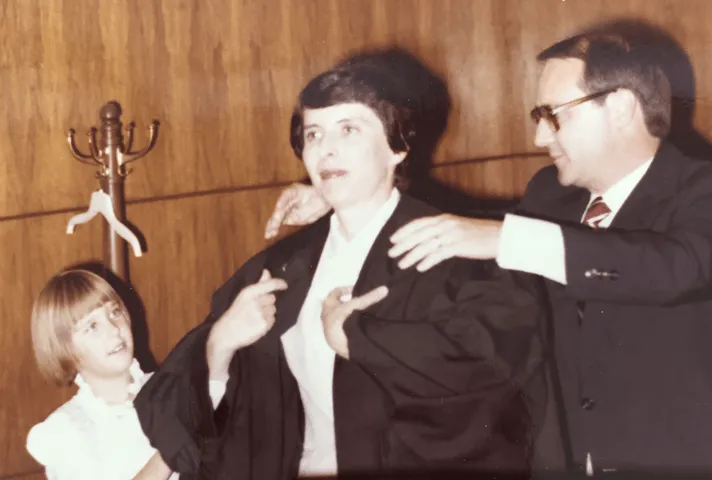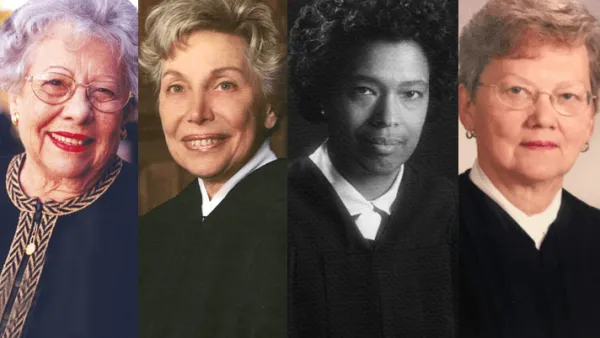
Judge Mary M. Schroeder, at her 1979 investiture as a judge for the Ninth Circuit U.S. Court of Appeals. With Schroeder are her husband, Milton, and her daughter Caroline, then 8. Not pictured is her daughter, Kate, then 2. Photo courtesy of Judge Schroeder.
In 1979, Mary Murphy Schroeder joined a historic class of women judges who transformed the federal Judiciary, but her law career nearly ended before it began. The night before her first final law exam at the University of Chicago, Schroeder collapsed and was hospitalized with a severe kidney infection.
“My professor planned to give me an F,” Schroeder recalled. “That would have ended law school for me. Fortunately, a very persuasive roommate talked to other faculty members, and they let me take the test.”

Judge Mary Murphy Schroeder. Photo courtesy of Judge Schroeder.
Schroeder and her fellow women judges of 1979 had to break many barriers. Entering the profession at a time when law firms and law schools were overwhelmingly male, women lawyers were at best oddities, and sometimes were treated as unwelcome.
After law school, Schroeder worked for the Justice Department civil rights division, but she encountered new roadblocks when she and her husband moved to Phoenix in 1969. Local law firms weren’t hiring women lawyers, and her first job was threatened when she learned she was pregnant.
Following the advice of the partner who hired her, Schroeder concealed her pregnancy as long as she could. She then kept her job by saying she would only take four weeks’ maternity leave—the same time off that male associates took for military reserve training. “My hiring partner just said, ‘Oh,” but he had a look of relief on his face,” Schroeder said.
Schroeder thrived in the male-dominated field of construction law, before serving on Arizona’s state appellate court. “I was surprised and a little frightened when I got the appointment” to the Ninth Circuit U.S. Court of Appeals in 1979, she recalled.
In 1987, Schroeder overturned a lingering injustice by reversing the World War II conviction of Gordon Hirabayashi, who had resisted the internment of Japanese Americans, and decades later sued to be exonerated.
Read the Series
This is the second in a series of articles about 23 women judges who in 1979 reshaped the federal Judiciary.
“It was a once in a lifetime case,” Schroeder said. When the government argued that Hirabayashi had been freed long ago and therefore had no injury to redress, Schroeder’s opinion contained an eloquent retort: “A United States citizen who is convicted of a crime on account of race is lastingly aggrieved.”
Throughout her career, Schroeder was conscious that she and fellow women judges were part of a historic wave. Schroeder knew Sandra Day O’Connor, who became a Maricopa County Superior Court judge in the mid-1970s, and 1979 was a momentous year for both jurists. When Schroeder was elevated to the federal bench, O’Connor filled her seat on Arizona’s state Court of Appeals. O’Connor held that position until 1981, when President Reagan named her to be the first woman on the U.S. Supreme Court.
In 1980, Schroeder and Ruth Bader Ginsburg were among a dozen women judges who met President Jimmy Carter at the White House. She proudly displays a photo of the gathering in her chambers.
“We all have that picture on our wall,” Schroeder said. “This is what so-called pioneers have had to be—determined and strong, and not willing to yield because we don’t belong.”
1979: The Year Women Changed the Judiciary
The number of women serving as federal judges more than doubled in 1979. In this series, learn more about the trailblazers who reshaped the Judiciary.
Subscribe to News Updates
Subscribe to be notified when the news section is updated.

